| Haras National de Lamballe | |
|---|---|
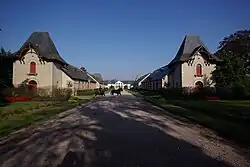 West entrance to the stud. | |
| General information | |
| Location | France, Brittany |
| Address | Haras Boulevard |
| Year(s) built | 1825-1907 |
| Landlord | Syndicat Mixte of the Haras National de Lamballe |
| Website | |
| https://www.haras-lamballe.com | |
The Haras National de Lamballe (English: Lamballe National Stud) is one of five equestrian centers in the French region of Brittany. Originally, it was a depot for royal stallions, created in the autumn of 1783 in the sole stable of a barracks in the town of Lamballe. Abolished in 1790, briefly recreated in 1825, this national stud took on its definitive form in 1842, when it was given the task of making breeding stallions available to the owners of the 70,000 broodmares in its district. Numerous extensions led to the construction of eleven new stables until the beginning of the 20th century, housing up to 350 stallions of all breeds. The National Stud played a major role in the development of the Norfolk-Breton breed, the future Breton horse, by importing Norfolk Trotter stallions from England. It was also responsible for the success of the half-Ardennes stallion Naous, one of the founding stallions of the Breton horse breed.
At the beginning of the 21st century, the Haras National de Lamballe came under the management of a Syndicat Mixte, losing its former role as a public stallion and turning to tourism and the preservation of the Breton horse. It welcomes between 60,000 and 75,000 visitors every year. Its listed heritage buildings include a renowned saddlery and a collection of 22 horse-drawn vehicles. It organizes numerous events, including the national Breton horse show, and Brittany's biggest equestrian festival, the Mille Sabots, held every September.

History
The Haras National de Lamballe is one of the cradles of the Breton horse breed, formerly known as the Norfolk-Breton.[1] The archives of this stud, between the years 1864 and 2016, occupied 252 linear meters, but only 49 linear meters have been preserved following archiving work completed in October 2018.[2]
Lamballe stallion depots
First depot, 1780-1790
A temporary stallion depot already existed in Lamballe in 1780, housing 19 horses, including 7 Breton bidets.[3] The creation of the stud dates back to a royal stallion depot initiated in 1783, following a report by the Rennes Academy of Agriculture.[4] The depot was set up in the autumn, in a stable in Lamballe's Saint-Martin barracks, with an annual rental fee of 240 pounds, and the hiring of two grooms and a master marshal for the eight royal stallions.[5] Four new stallions arrived in February 1785, then two were transferred from the bishopric of Saint-Malo. A veterinarian trained at Alfort was appointed in 1785.[6] The stallion depot was abolished in 1790, as were all other royal stud farms and depots.[4]
Attempts to restore the depot
The depot was gradually restored under the Empire.[4] On June 24, 1807, the Prefect was ordered to visit the Ursuline and Augustinian convent in his town, and then on September 3, the Sainte-Catherine convent: none of these locations was chosen for a stallion depot.[7] On January 7, 1809, the Minister wrote that the installation costs were too high to establish a stallion depot in Lamballe.[8]
In 1814, the remaining stallions were evicted from the barracks to make room for prisoners of war.[9] In 1819, Lamballe mayor Collas de la Baronnais reported that foreign horse traders were buying the commune's best animals from breeders; he again called for a stallion depot in 1818 and 1819.[10][8] The following year, six stallions were sent by the stud farm administration to the town of Lamballe, to the home of innkeeper Lagadec.[11] Lagadec was caught breeding his own horses to the detriment of those entrusted to him, and not charging the prescribed prices.[12] The mayor suggested housing the stallions in the Saint-Martin barracks.[13]
Second depot, 1825-1833
In 1825, the attempt to create a real stud farm failed.[1] The mayor of Lamballe called for a stallion depot to be set up in his town, and the Dinan arrondissement council passed a resolution to this effect. A royal decree of January 16, 1825, concerning the reorganization of the national stud farms, ordered the purchase of the Saint-Martin barracks (then owned by M. Micault de Mainville) by the town of Lamballe; the town and the département then contributed financially to the installation work.[6][14] M. Gravé de la Rive was appointed head of the depot, then quickly replaced by M. Thiery at the end of 1828, who was in turn replaced by M. de Coëtquen des Ormeaux de Coëtdihuël.[8] M. de Salinis ran the depot from 1831 until its closure in 1833.[15] Four stallions were acquired between 1826 and 1830.[6] The Côtes-du-Nord equestrian commission, meeting in February 1829, emphasized the high quality of the department's broodmares, and asked Lamballe for funds to buy the best local stallions before they were sold commercially.[15][16] However, with the opening of the Haras National de Langonnet, the creation of a stallion depot in Lamballe was deemed unnecessary.[6] The depot was administratively abolished for budgetary reasons in 1833.[17] A letter from the Prefect dated March 5, 1834 ordered the transfer of equipment and horses to Langonnet.[15][18] The development costs incurred were lost, and the four stallions were transferred to Langonnet.[6] The depot was officially closed in 1834, after eight years and four different directors.[15] This led to protests, notably in the Journal des Haras.[19] The closing of the depot is noted in the register of the Côtes-du-Nord equestrian commission as a "calamity that spreads discouragement among breeders".[16] Numerous complaints from breeders reached the prefect and the general council, as the transfer of equine breeding activities to Langonnet for the entire Côtes-du-Nord department caused major disruption.[20][21] In December 1835, the prefect forwarded these complaints to the minister, deploring the costs incurred by the town and the département, to no avail.[20] In 1836, the General Council asked for the Lamballe stallion depot to be re-established.[22]
Definitive creation of the stud farm
Against a backdrop of opposition between the military and stud administrations, on November 12, 1842, a royal decree divided the management of national stud activities in the former province of Brittany into two parts: the departments of Côtes-du-Nord and Ille-et-Vilaine fell to the Lamballe stud, which was then created in its definitive form.[1][23][24][25][26]
We believe we can now announce that the re-establishment of the Lamballe stallion depot has been positively decided, and that the ordinance will be published shortly. Situated in the midst of fertile, well-cultivated regions, immensely rich in beautiful broodmares, this establishment cannot fail to produce the greatest good and to contribute powerfully to the improvement of the various breeds of horse that are spread over the soil of Brittany.
— A. de Rochau
At the time, it had only one stable. A second stable of the same size was built the same year1. This public stud was theoretically responsible for the 70,000 broodmares in the two départements, many of which were bred by private stallions.[1] The stud was briefly managed by M. Paulin de Thélin, who managed to generate substantial revenues, despite the cost of the work, which had put the town of Lamballe into debt.[25] His management was controversial due to his kinship with Achille de Montendre, and the struggle between the stud farm administration and the military remontes administration.[27] Many vicissitudes followed, with frequent changes of management between 1842 and 1852.[28]
In 1842, the stud welcomed Brittany's first Norfolk Trotter stallion, Sir Henry Dimsdale, who bred for a year before being transferred to the Haras National de Saint-Lô.[25] At this time, the stud also housed Percheron diligence horses and military saddlebred stallions of the Thoroughbred, Arabian and Anglo-Norman types.[1] In 1844, there were 35 stallions, including 7 Thoroughbreds.[29] An incident was reported in 1852, when the inspector general of remounts, General des Carrières, visited the farm and declared that horses from the south of France (Arabs and Beards) were better suited to the haras and stations of southern France.[30] The mayor of Lamballe reports to the prefect, who informs the minister of his wish to keep Arabian and Barb stallions at the Lamballe stud.[30]
In 1857, the Haras National de Lamballe received a brief visit from Napoleon III.[1][31] In 1864, the trotting stallion Norfolk Flying Cloud was imported from England to the Lamballe stud; he was to become the sire of Corlay, one of Brittany's most famous stallions.[32] The departmental boundaries were changed in 1860, with Lamballe taking charge of the northern part of the Finistère département, while the Ille-et-Vilaine département was entrusted to the Haras National d'Hennebont.[1] In 1865, a report from the Haras Administration stated that, without wishing to proscribe the breeding of draft horses, it would be useful to replace Lamballe's draft stallions with Anglo-Norman and Norfolk stallions.[33]
Following France's defeat in the Franco-Prussian War of 1870, the Lamballe stud was expanded with the construction of stables no. 3 to no. 7, providing accommodation for 350 stallions. Thanks to a warm welcome from breeders, Lamballe increased its imports of Norfolk trotter stallions from England, via northern Finistère. The first attempts to breed the artillery horse by crossing with the Norman carriage driver, aimed at supplying military horses after the defeat of 1870, were unsuccessful.[1] On September 20, 1871, the director of the Lamballe stud farm, M. Benéteau, sent a report to the board of directors. Benéteau sent a report to the departmental council, in which he deplored the "routine and mistrust" of local draft horse breeders, and called for the development of lighter, faster horses.[34][35] From 1885 onwards, there was considerable resistance to the stud's breeding policy.[36]
From 1900 to 1950
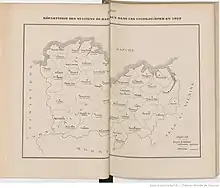
Breeding activities were reorganized in 1900 with the appointment of a new director, Mr. Dupont-Auberville.[37] The stud also suffered a fire that same year, destroying part of its archives:[2] no more statistics are available between 1870 and 1900.[38] The appointment of a Breton-born stud inspector, Mr. Auguste Ollivier, and Mr. Dupont-Auberville's position as director in Lamballe, provided support for traction horse breeding.[39] He brings to Lamballe a renowned Norfolk stallion by the name of Denmark Vigorous. In 1909, he worked with M. de Robien to create competitions for harnessed artillery horses.[37]
Before the World War I, traction horse breeding had become extremely prosperous.[40] The conflict decimated the horses concerned, but at the same time encouraged breeding activities. During the war, Lamballe's stallions were in great demand in the hope of replenishing the military horse population.[41] In 1917, the Lamballe stud district had 65,000 mares and 391 national stallions, compared with 1,017 private stallions. During the interwar period, the Corlay station, managed by Lamballe, focused on breeding gallopers, while the Breton breed bred at Lamballe became heavier through crossbreeding with the Ardennais, while retaining the gaits inherited from the Norfolk trotter.[37][42] In 1927, the Haras National de Lamballe was the second largest in France, with 127 sub-agents.[17] In 1928, it housed 384 stallions, including 324 of Breton breed.[43] In 1938, the Lamballe stud suddenly gained in reputation thanks to the stallion Naous, who had arrived at the Callac station. This master of the breed reproduced for 14 years. Just before the World War II, the stud had 327 breeding stallions, most of them draft, for the 21,000 mares in its district. In the second half of the 20th century, the Lamballe stud was able to maintain its breeding activity thanks to the conversion of draft horses to meat, and the development of racehorse and sporthorse breeding.[44]
From the 1950s to 2000
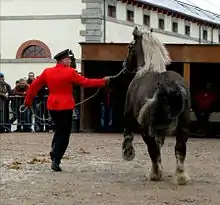
In the 1970s, director Jacques Lippens initiated a wave of Connemara pony imports.[45]
In 1980, the Lamballe stud employed 68 staff and had 103 Breton stallions, 21 of which were saddle horses or ponies. The decline in the draft horse market reduced this figure to 46 Breton stallions in 1993, but the number of covers per stallion increased, testifying to the efficiency of the establishment, and to the improved quality of breeding equipment, with increasing use of ultrasound.[44][46] The stud was one of the first to introduce artificial insemination for its draft stallions, in 1980.[47]
In the early 1990s, the Haras National de Lamballe managed the breeding of some 2,000 mares, as well as stud farms in the towns of Bégard, Bourbriac, Callac, Corlay, Lannion, Loudéac, Merdrignac, Quintin, Rostrenen, Landivisiau, Lanmeur, Lannilis, Saint-Pol-de-Léon and Saint-Renan. It also houses horses and ponies belonging to riding associations, and young horses in training, outside the breeding season.[46] In 1990, together with the Haras d'Hennebont and the Breton Horse Breeders' Union, it began to organize carriage driving competitions for draft horses.[48] In 1993, Breton stallions from the Lamballe stud took part in the first French interbreed endurance cup for draft horses.[49]
Transition to syndicat mixte management
In July 2006, the Haras de Lamballe Syndicat Mixte was created. It includes four local authorities: the Brittany region, the Côtes-d'Armor département, Lamballe Communauté and the town of Lamballe.[50]
On October 15, 2015, the Institut français du cheval et de l'équitation (IFCE by its acronym in French) announces that this stud, like all the sites it manages that are not national in vocation, will be put up for sale in January 2016, unless an agreement or partnership is signed before the end of the year.[51] Investors are few and far between, but the equestrian vocation of the site should not be called into question.[52] The syndicat mixte will acquire the Lamballe stud farm in autumn 2016.[53] The evolution of the site's function includes accentuating its equestrian vocation by diversifying the breeds of horses accommodated, welcoming residents, organizing shows and art exhibitions, creating a museum and innovating.[53]
A prefiguration association for the public interest group aimed at preserving the Breton horse was created in December 2014, and has since been based at the Lamballe stud farm. It takes over the calibration missions previously carried out by the IFCE.[50] In 2015, a rapprochement, then a twinning, is envisaged between the Lamballe stud and the El Batan stud in Tunisia.[54]
The stud receives a 130,000 euro subsidy from the Brittany region for its operations in 2019.[55]
Site description
The Haras National de Lamballe is located in the city center.[56] Compared with other French national stud farms, its buildings are concentrated in a relatively small area of around 5 hectares.[57]

Heritage buildings

The stud includes 12 stables, all built between 1825 and 1907.[58] These Napoleonic-style red-brick buildings feature similar functional architecture.[56]
The oldest building at the Lamballe stud is stable no. 1, whose walls date back to the late 18th century. Stable no. 2, opposite, was built in 1842. The adjutant's and deputy director's quarters are located between these two stables, and were built on the site of a former main gate. All other buildings - stables, offices and tack room - date from the late 19th century. Two rows of symmetrical stables abutting the main entrance were built perpendicular to each other, on the site formerly known as "La ferme du Pavillon", at the time of management by Mr. Dupont-Auberville.[57] A stable with stalls built before 1907 was restored in 2005 to become a venue for art exhibitions and educational events, the "Ecurie des Arts".[59]
The stud also features a horse-drawn carriage shed, a forge, a hangar and a water tower.[56]
 Former stables, equipped with stalls.
Former stables, equipped with stalls.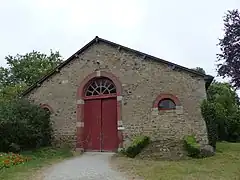 Shed for horse-drawn vehicles.
Shed for horse-drawn vehicles.
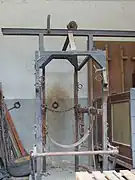 A cattle shut.
A cattle shut.
The stud farm was listed as a historic monument by decree on December 11, 2015: this concerns all buildings dating from before the World War I, as well as stable no. 10, and concerning the park, its base ground, walls, fences and gates.
Equestrian facilities
A large riding arena was built in 1962,[46] then renovated in 2011, in a brightly colored ambiance that contrasts with the rest of the site. Designed for sports and public use, it features a 130-seat fixed tier and 16 alcoves for 128 people. A removable bleacher can increase capacity to a total of 600.[60]
The rond d'Havrincourt, or presentation arena, renovated in 2012, is designed for the presentation of young horses and free jumping. Measuring 38 x 18 meters, it has a fiber-reinforced sand floor and a removable paddock.[60]
The Lamballe stud has one of the largest main arenas of all national studs, measuring 35 meters wide by 135 meters long. This arena is used for competitions and events.[60]
Finally, the 13-hectare equestrian park is open to walkers and horse professionals alike, thanks to differentiated trails and regulated use.[60]
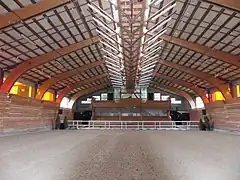 The big carousel.
The big carousel.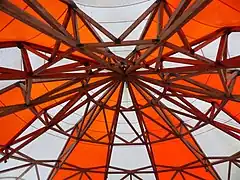 Carpentry for the covered display arena.
Carpentry for the covered display arena.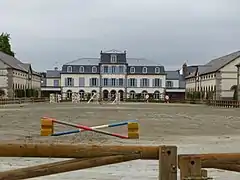 The quarry of honor, with the officers' building in the background.
The quarry of honor, with the officers' building in the background.
Collections

The stud farm has a large fleet of heritage horse-drawn vehicles, with 22 horse-drawn vehicles,[61] including an horse-bus, a marathon, a tilbury and brake.[59]
The saddlery from Château de Beaumanoir (near Quintin), on display in the "grain room" of stable no. 10, was donated by the Saint-Pierre couple in 2006.[58] This collection includes many equestrian objects used before the beginning of the 20th century, notably equine dentistry tools and one of the first models of mechanical clippers.[59]
The stud's main saddlery displays a very important collection of harnesses, testifying to the past importance of Breton horse horse drivers.[58] These harnesses of various models are stamped with the official brand of the National Stud. The saddlery also exhibits various models of saddles, including amazon saddles.[59]
Vegetation
The Lamballe stud site boasts a large number of tree species and varieties of flowering plants. More than 35 varieties of rose are found on the site, as well as pontic rhododendron. The site's trees include a hundred-year-old Juglans nigra, a 122-year-old giant sequoia listed as a département tree of note, and a 60-year-old Cedrus atlantica.[62]
Management
A number of stud farm directors and inspectors have left their mark on Lamballe's history. For example, according to Commandant Saint-Gal de Pons, Mr. Ollivier, Inspector General of the studs at the beginning of the 20th century, "deserves to have his name inscribed in gold letters on the splendors of the Lamballe depot", because of his efforts to promote the Breton letter carrier as an artillery horse, which contributed greatly to the service of the French army and to the economic prosperity of this region of Brittany.[63] Refusing other assignments, he remained with the western stud farms for 27 years.[36] Considered the "great director" of Lamballe, Mr. Dupont-Auberville "placed Lamballe on an unrivalled footing" and was a fine driver, whose passage through the streets of the town of Lamballe was noticed.[64]
Mr. J. Gendry, deputy director of Lamballe during the World War II, was interned three times for resistance, once by the Gestapo.[65] The stud was managed by Mr. Charpy from 1942 to 1957, then by Mr. Roche until 1972, and finally by Mr. Quatrebarbes and Mr. Arnauld.[44]
| Name[66][67] | Working years[66][67] | Functions[66][67] |
|---|---|---|
| M. Gravié de la Rive | January 1, 1825 | |
| M. Thiéry | 1826 or March 21, 1828 - December 1, 1828 | |
| M. de Coëtdihuël | 1826 or December 1, 1828 - 1831 or 1832 | Warehouse Manager, then Director |
| M. de Salinis | 1832 - 1833 (dissolution of the depot); 1834 - 1842 | |
| M. Paulin de Thélin | August 12, 1842 - 1848 | |
| M. Delbose d'Auzon | 1848 - 1859 | |
| M. Sarrans | January 1, 1849 - May 1, 1850 | |
| M. le baron de Taya | May 1, 1850 - October 6, 1852 | General Inspector and General Director |
| M. de Bourgoing | October 6, 1852 - January 1, 1853 | |
| M. de la Houssaye | January 1, 1853 - February 1, 1862 | General Inspector |
| M. Benéteau | February 10, 1862 - February 10, 1874 | |
| M. de la Motte-Rouge | February 10, 1874 - July 1, 1880 | General Inspector |
| M. de Fontrobert | July 1, 1880 - 3 mai 1887 | General Inspector |
| M. Chambry | May 3, 1887 - January 1, 1890 | General Inspector |
| M. Quinchez | January 1, 1890 - July 1, 1892 | General Inspector |
| M. de Pardieu | August 1, 1892 - March 1, 1900 | General Inspector and General Director |
| M. Dupont-Auberville | March 22, 1900 - May 1, 1917 | |
| M. Gaillard | May 1, 1917 - December 7, 1922 | |
| M. Le Harivel de Gonneville | December 16, 1922 - August 16, 1923, then 1923 - 1942 | In charge of stud farms, then director |
| M. Charpy | 1942 - 1957 | General Inspector |
| M. Roche | 1957 - 1972 | |
| M. Jacques Lippens | 1972 - ? | |
| M. Philippe de Quatrebarbes | ||
| M. Arnauld |
Missions, events and tourism
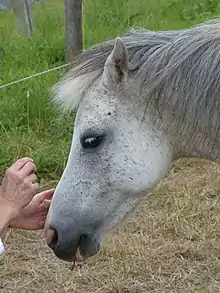
The Haras National de Lamballe has historically organized competitions for Breton fillies, broodmares, young saddle horses and young show jumpers, two national horse shows each year, a Breton stallion purchasing event, and sales of young saddle horses.[46] The most famous event of the year is the carriage driving competition in the Grande Cour.[57] The stud hosts the Breton National Horse Show in September 2018,[68] and a leg of the Grand National show jumping competition in June 2019.[69] In February 2019, show jumping and video game star Alexandra Ledermann will give a training session there.[70] The stud also hosts equitherapy and personal development sessions using horses.[71][72]
The syndicat mixte du haras de Lamballe is now in charge of all the site's organizations and events.[50] Its main focus is on tourism, but it is also committed to promoting the Breton horse.[73] The syndicat mixte supports a project for a territorial Breton horse in the streets of Lamballe.[74]
Guided tours of the stud farm are possible,[58][75] and are then dramatized with short sketches.[76] The stud also offers young people and teenagers the chance to discover the world of horses through immersive courses.[77]
Mille Sabots
The most important event organized at the Haras National de Lamballe is Les Mille Sabots, which, according to its official website, has attracted between 15,000 and 20,000 visitors since its first edition in 1999, who come to see around 250 horses free of charge at each edition. Les Mille Sabots is also the biggest equestrian festival in the Brittany region.[78] Traditionally, it kicks off with a parade of riders, carriages and horses through the streets of Lamballe. An artist of honor then performs in the main arena of the Haras National de Lamballe, where a variety of events take place (pony games, show jumping, in-hand horse presentations, driving, dressage...). The event also features bivouacs for walkers and various technical demonstrations.[79]
Jeudis du haras
The syndicat mixte du haras de Lamballe organizes Jeudis du haras (in French) (Englishː Haras Thursdays) events and shows every Thursday.[80] An equestrian show featuring Breton Trait and Postier horses is organized. Guided rides, pony and carriage rides are also available.[81] For the 2019 season, the show will be presented by a jazz artist from Brest.[82] The first show of the 2019 season, Cheval mon histoire, was sold out.[83]
Art exhibitions
Art exhibitions (paintings, sculptures, photographs, etc.) are organized in a dedicated stable, Stable No. 10, with wrought-iron swan-neck stalls; exhibitions of equestrian art are given priority.[84] In July 2014, a collection of 2,000 photographs and several hundred objects related to the groom's trade is presented.[85] In July 2019, old photographs of Lamballe's past will be displayed on the gates of the stud farm, and circular paintings in the aisles.[86][76]
Christmas market
The stud farm's Christmas market, in existence since 2009, attracts around 20,000 visitors each year (2017 and 2018 figures).[87] It takes place over three days, offering exhibitions, crafts, entertainment and shows.[88][89]
See also
References
- 1 2 3 4 5 6 7 8 Barbié de Préaudeau (1994, p. 18)
- 1 2 "Haras national. Une histoire archivée par Morgan Le Dez". Le Télégramme. 2018. Retrieved 9 August 2019.
- ↑ Saint-Gal de Pons (1931, p. 32)
- 1 2 3 Barbié de Préaudeau (1994, p. 5)
- ↑ Guillotel (1986, p. 290)
- 1 2 3 4 5 Guillotel (1986, p. 291)
- ↑ Saint-Gal de Pons (1931, p. 101)
- 1 2 3 Saint-Gal de Pons (1931, p. 102)
- ↑ Durand, René (1926). Le département des Côtes-du-Nord sous le Consulat et l'Empire (1800-1815) : essai d'histoire administrative (in French). F. Alcan. p. 51.
- ↑ Saint-Gal de Pons (1931, p. 90)
- ↑ Saint-Gal de Pons (1931, p. 92)
- ↑ Saint-Gal de Pons (1931, p. 93)
- ↑ Saint-Gal de Pons (1931, p. 94)
- ↑ Frouin (1927, p. 35)
- 1 2 3 4 Saint-Gal de Pons (1931, p. 103)
- 1 2 Saint-Gal de Pons (1931, p. 104)
- 1 2 Frouin (1927, p. 36)
- ↑ Guillotel (1986, p. 293)
- ↑ Guillotel (1986, p. 294)
- 1 2 Saint-Gal de Pons (1931, p. 125)
- ↑ Saint-Gal de Pons (1931, p. 233)
- ↑ Saint-Gal de Pons (1931, p. 234)
- ↑ Saint-Gal de Pons (1931, pp. 127–129)
- ↑ Barbié de Préaudeau (1994, p. 9)
- 1 2 3 Guillotel (1986, p. 295)
- ↑ de Rochau, A. "Rétablissement du dépôt royal d'étalons de Lamballe (Côtes-du-Nord) et création d'un nouveau dépôt d'étalons à Bourbon-Vendée". Journal des haras des chasses et des courses de chevaux, recueil périodique consacre à l’étude du cheval, à son éducation (etc.), Bureau du journal (in French). 31.
- ↑ Saint-Gal de Pons (1931, pp. 130–131)
- ↑ Saint-Gal de Pons (1931, p. 135)
- ↑ Guillotel (1986, p. 296)
- 1 2 Saint-Gal de Pons (1931, p. 246)
- ↑ Guillotel (1986, p. 298)
- ↑ Saint-Gal de Pons (1931, p. 164)
- ↑ Saint-Gal de Pons (1931, pp. 162–164)
- ↑ Guillotel (1986, p. 301)
- ↑ Saint-Gal de Pons (1931, p. 166)
- 1 2 Guillotel (1986, p. 302)
- 1 2 3 Barbié de Préaudeau (1994, p. 20)
- ↑ Frouin (1927, p. 37)
- ↑ Guillotel (1986, pp. 302–303)
- ↑ Guillotel (1986, p. 305)
- ↑ Guillotel (1986, p. 307)
- ↑ Frouin (1927, p. 40)
- ↑ Saint-Gal de Pons (1931, p. 277)
- 1 2 3 Barbié de Préaudeau (1994, p. 22)
- ↑ Rebts, Marie-Eve (2014). "Le connemara, pour toutes les ambitions". Cheval Magazine (in French) (513): 78–81.
- 1 2 3 4 Barbié de Préaudeau (1994, p. 24)
- ↑ Insémination artificielle équine (in French). Le Pin-au-Haras, Les Haras nationaux. 2009. p. 271. ISBN 978-2-915250-15-2.
- ↑ Lizet (1996, p. 138)
- ↑ Lizet (1996, p. 161)
- 1 2 3 "Le Haras et son histoire". www.haras-lamballe.com (in French). Retrieved 11 August 2019.
- ↑ "Haras. Les sites de Lamballe et d'Hennebont bientôt mis en vente". Le Télégramme. Retrieved 8 November 2015.
- ↑ "Haras. Les sites bretons seront mis en vente". Ouest France Entreprises. Retrieved 28 December 2015.
- 1 2 "Lamballe. " La réappropriation du Haras national a commencé"". Ouest-France. 2018. Retrieved 9 August 2019.
- ↑ "Haras. Un jumelage avec un haras tunisien ?". Le Télégramme. 2015. Retrieved 6 September 2019.
- ↑ "Lamballe-Armor - Haras national. Une aide de 130 000 euros de la Région Bretagne". Le Télégramme. 2019. Retrieved 8 August 2019.
- 1 2 3 "Une architecture d'exception". www.lamballe-terre-mer.bzh (in French). Retrieved 9 August 2019.
- 1 2 3 Guillotel (1986, p. 312)
- 1 2 3 4 "Haras national de Lamballe". Les Haras nationaux. Retrieved 9 August 2019.
- 1 2 3 4 "Selleries, voitures hippomobiles et objets de collection". www.haras-lamballe.com (in French). Retrieved 9 August 2019.
- 1 2 3 4 "Ses équipements de choix". www.haras-lamballe.com. Retrieved 9 August 2019.
- ↑ "Lamballe-Armor - Parc hippomobile. Un patrimoine à conserver aux Haras". Le Télégramme. 2019. Retrieved 8 August 2019.
- ↑ "Rosiers, arbres et espèces remarquables". www.haras-lamballe.com. Retrieved 9 August 2019.
- ↑ Saint-Gal de Pons (1931, p. 168)
- ↑ Guillotel (1986, p. 303)
- ↑ Guillotel (1986, p. 310)
- 1 2 3 Guillotel (1986, p. 315)
- 1 2 3 Saint-Gal de Pons (1931, p. 178)
- ↑ "Haras. Les plus chevaux bretons au parc équestre". Le Télégramme. 2018. Retrieved 9 August 2019.
- ↑ "Lamballe. Le concours de saut d'obstacles Grand National fait escale au haras". Ouest-France. 2019. Retrieved 9 August 2019.
- ↑ "Haras. Alexandra Ledermann présente ce week-end". Le Télégramme. 2019. Retrieved 9 August 2019.
- ↑ "" Mardis des Sens ". Équithérapie et art équestre". Le Télégramme. 2018. Retrieved 11 August 2019.
- ↑ Tremblais, Sonia (2018). "Du horse coaching avec Émilie au haras national de Lamballe". Ouest-France. Retrieved 11 August 2019.
- ↑ "Lamballe. Spectacle équestre, Régalades… L'été sera chaleureux et joyeux !". Ouest-France. 2019. Retrieved 9 August 2019.
- ↑ "INSOLITE. Lamballe. Dans le centre-ville, on arrose les jardinières à cheval !". Ouest-France. Retrieved 9 August 2019.
- ↑ Rouault, Capucine (2019). "Lamballe. Visite guidée du haras national, à la croisée de l'histoire et des chevaux". Ouest-France. Retrieved 9 August 2019.
- 1 2 "Lamballe-Armor - Haras National. Une visite guidée théâtralisée". Le Télégramme. 2019. Retrieved 9 August 2019.
- ↑ "Lamballe-Armor - Enfance jeunesse LTM. Une semaine en immersion au haras". Le Télégramme. 2019. Retrieved 9 August 2019.
- ↑ "Lamballe. Mille Sabots déboule ce dimanche". Le Télégramme. 2018. Retrieved 9 August 2019.
- ↑ "Mille Sabots". www.haras-lamballe.com. Retrieved 9 August 2019.
- ↑ "Lamballe Armor. Les Jeudis du Haras". www.letelegramme.fr. 2019. Retrieved 9 August 2019.
- ↑ "Les jeudis du Haras". www.haras-lamballe.com. Retrieved 9 August 2019.
- ↑ "Lamballe-Armor - Haras. Marion Thomas est Mme Loyale". Le Télégramme. 2019. Retrieved 9 August 2019.
- ↑ "Lamballe-Armor - Haras. Chaque jeudi, le cheval, c'est toute une histoire !". Le Télégramme. 2019. Retrieved 9 August 2019.
- ↑ "Art et expositions". www.haras-lamballe.com. Retrieved 9 August 2019.
- ↑ "Bernard Coupé sauvegarde la mémoire du palefrenier". Ouest-France. 2014. Retrieved 9 August 2019.
- ↑ Quéro, Soizic (2019). "EN IMAGES. Lamballe. Des photos anciennes inattendues sur les grilles du Haras national". Ouest-France. Retrieved 9 August 2019.
- ↑ "Lamballe. 20 000 visiteurs attendus aux écuries du Père Noël". Le Télégramme. 2018. Retrieved 8 August 2019.
- ↑ "Les Écuries du Père Noël". www.haras-lamballe.com. Retrieved 9 August 2019.
- ↑ "À Lamballe, le plein de cadeaux aux Écuries du Père Noël". Ouest-France. 2018. Retrieved 9 August 2019.
Bibliography
- Barbié de Préaudeau, Philippe (1994). Haras de Bretagne (in French). Édilarge. ISBN 2-7373-1330-9.
- Frouin, E. (1927). Le cheval breton (in French). Saint-Brieuc : imp. moderne, rues Lamennais et Saint-Benoit.
- Guillotel, Gérard (1986). Les Haras Nationaux (in French). Éditions Lavauzelle. ISBN 2-7025-0134-6.
- Lizet, Bernadette (1996). Champ de blé, champ de course : Nouveaux usages du cheval de trait en Europe. Bibliothèque équestre (in French). Jean-Michel Place. ISBN 2-85893-284-0.
- Rochard, Y. (1995). Les haras de Lamballe (in French). Ar Men.
- Saint-Gal de Pons, Antoine-Auguste (1931). Les Origines du cheval breton (in French). A. Prud'homme.